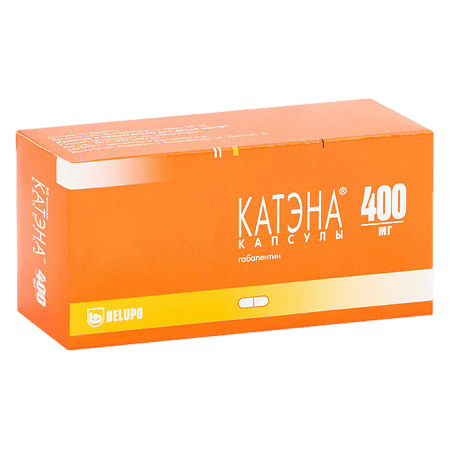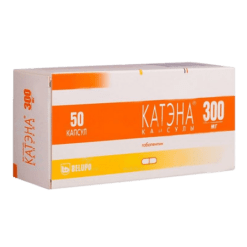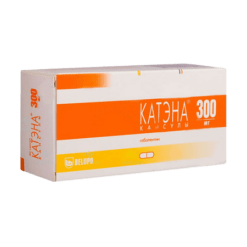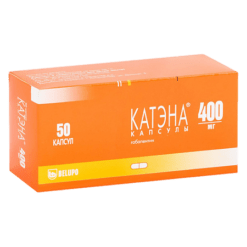No products in the cart.
Catena, 400 mg capsules 100 pcs
€54.52 €47.25
Description
A anticonvulsant drug. Gabapentin is similar in structure to the neurotransmitter GABA (GABA), but its mechanism of action differs from that of some other drugs that interact with GABA receptors, including valproate, barbiturates, benzodiazepines, GABA transaminase inhibitors, GABA capture inhibitors, GABA agonists and prodrug forms of GABA: it has no GABAergic properties and has no effect on GABA capture and metabolism.
Preliminary studies have shown that gabapentin binds to the α2-δ-subunit of voltage-dependent calcium channels and suppresses calcium ion flux, which plays an important role in causing neuropathic pain. Other mechanisms involved in the action of gabapentin in neuropathic pain are: reduction of glutamate-dependent neuronal death, increase of GABA synthesis, suppression of monoamine group neurotransmitter release.
Gabapentin in clinically relevant concentrations does not bind to receptors of other common drugs or neurotransmitters, including GABAA, GABAB, benzodiazepine, glutamate, glycine or N-methyl-D-aspartate receptors.
Unlike phenytoin and carbamazepine, gabapentin does not interact with sodium channels.
Indications
Indications
Active ingredient
Active ingredient
How to take, the dosage
How to take, the dosage
Catena® is administered orally, regardless of meals. If it is necessary to reduce the dose, stop the drug or replace it with an alternative medicine, this should be done gradually over at least one week.
Neuropathic pain in adults
The starting daily dose is 900 mg (in 3 equal doses); if necessary, depending on the effect, the dose is gradually increased to a maximum of 3.6 g/day. Treatment may begin immediately with a dose of 900 mg/day (300 mg 3 times/day), or during the first 3 days the dose may be gradually increased to 900 mg per day according to the following scheme:
Partial seizures
Adults and children over 12 years of age
The effective dose is 900 mg to 3.6 g daily. Therapy may be started with a dose of 300 mg 3 times daily on day 1 or increased gradually to 900 mg according to the regimen described above (see Neuropathic pain in adults). Subsequently, the dose may be increased to a maximum of 3.6 g/day in 3 doses in equal doses. The maximum interval between doses at three doses of the drug should not exceed 12 hours in order to avoid recurrence of seizures. There is good tolerability of the drug in doses up to 4.8 g/day.
Children aged 3-12 years
The initial dose of the drug varies from 10 to 15 mg/kg/day, which is administered in equal doses 3 times/day and increased to effective doses over approximately 3 days. The effective dose of gabapentin in children aged 5 years and older is 25-35 mg/kg/day in equal doses of 3 doses. Effective dose of gabapentin in children aged 3 to 5 years is 40 mg/kg/day in equal doses of 3 doses. There is good tolerability of the drug in doses up to 50 mg/kg/day in long-term use. The maximum interval between doses of the drug should not exceed 12 hours in order to avoid recurrence of seizures.
It is not necessary to monitor the plasma concentration of gabapentin. Catena® may be used in combination with other anticonvulsants without regard to changes in its plasma concentrations or serum concentrations of other anticonvulsants.
Dose selection in renal impairment
Patients with renal impairment are recommended to reduce the dose of gabapentin according to the table.
* The daily dose should be administered in 3 doses.
** Prescribe 300 mg every other day.
Patients on hemodialysis who have not previously taken gabapentin are advised to prescribe a saturation dose of 300-400 mg and then use 200-300 mg every 4 hours of hemodialysis.
Interaction
Interaction
Concomitant administration of gabapentin and morphine, when morphine was taken 2 hours prior to gabapentin administration, showed a 44% increase in mean AUC of gabapentin compared to gabapentin monotherapy, which was associated with an increase in pain threshold (cold pressor test). The clinical significance of this change has not been established, and the pharmacokinetic characteristics of morphine were not altered. Side effects of morphine co-administration with gabapentin did not differ from those of morphine co-administration with placebo.
There were no interactions between gabapentin and phenobarbital, phenytoin, valproic acid and carbamazepine. Equilibrium pharmacokinetics of gabapentin are similar in healthy subjects and patients receiving other anticonvulsants.
The concomitant use of gabapentin with oral contraceptives containing norethisterone and/or ethinylestradiol was not accompanied by changes in the pharmacokinetics of both components.
The concomitant use of gabapentin with antacids containing aluminum and magnesium is accompanied by a decrease in the bioavailability of gabapentin by approximately 20%. It is recommended to take gabapentin about 2 hours after taking an antacid.
Probenecid has no effect on renal excretion of gabapentin.
The slight decrease in renal excretion of gabapentin with concomitant administration of cimetidine is probably not clinically relevant.
Special Instructions
Special Instructions
In co-therapy with morphine, patients may experience increased concentrations of gabapentin. Patients should be closely monitored for signs of CNS depression, such as drowsiness. In this case, the dose of gabapentin or morphine must be adequately reduced.
When gabapentin and other anticonvulsants are used together, false-positive results have been reported with the Ames N-Multistix SG® urine protein test strips. The more specific sulfosalicylic acid precipitation method is recommended for determining protein in urine.
Impact on driving and operating machinery
At the time of treatment it is necessary to refrain from driving vehicles and engaging in potentially dangerous activities requiring increased concentration and quick psychomotor reactions.
Features
Features
Absorption
The bioavailability of gabapentin is not proportional to the dose; it decreases with increasing dose. After oral administration Cmax gabapentin in plasma is reached after 2-3 hours. Absolute bioavailability of gabapentin in capsules is about 60%. Food, including those with high fat content, has no effect on pharmacokinetics. The plasma excretion of gabapentin is best described using a linear model.
Distribution
The pharmacokinetics do not change with repeated administration. Css in plasma can be determined based on the results of a single drug administration. Gabapentin is practically not bound to plasma proteins (d – 57.7 l.
Metabolism
There is no evidence of metabolism in humans.
The drug does not induce hepatic oxidative enzymes with mixed function involved in drug metabolism.
Elevation
T1/2 plasma is independent of dose and averages 5-7 h. It is excreted exclusively by the kidneys unchanged.
Pharmacokinetics in special clinical cases
The plasma clearance of gabapentin is decreased in the elderly and patients with impaired renal function. The elimination rate constant, plasma clearance and renal clearance are directly proportional to creatinine clearance. Gabapentin is removed from plasma by hemodialysis. Dose adjustment is recommended in patients with impaired renal function and patients receiving hemodialysis treatment.
The plasma concentrations of gabapentin in children aged 4 to 12 years have been found to be generally similar to those in adults.
Contraindications
Contraindications
Precaution should be used when there is renal impairment
Precaution should be used when there is renal impairment.
Patients on hemodialysis who have not previously taken gabapentin are advised to prescribe the drug in a saturation dose of 300-400 mg and then use 200-300 mg every 4 hours of hemodialysis.
Contraindicated in children under 3 years of age.
Side effects
Side effects
Cardiovascular system disorders: symptoms of vasodilation, hypertension.
Digestive system disorders: dyspepsia, flatulence, nausea, vomiting, abdominal pain, constipation, diarrhea, dry mouth or throat, anorexia, gingivitis, dental disease, increased appetite, increased activity of liver transaminases.
Muscular system disorders: myalgia, arthralgia, back pain, increased bone fragility.
Nervous system disorders: drowsiness, dizziness, ataxia, amnesia, confusion, poor coordination, increased fatigue, thought disorder, tremor, hypoesthesia, depression, dysarthria, insomnia, nervousness, nystagmus, increased, decreased or absent reflexes, asthenia, anxiety, hostility, hyperkinesia, emotional lability.
Respiratory system: pharyngitis, rhinitis, shortness of breath, cough, pneumonia, bronchitis, respiratory infections.
Treatment of the urinary system: urinary tract infections, impotence.
Sensory organs: visual impairment, amblyopia, diplopia.
Hematopoietic disorders: leukopenia, purpura (most often described as bruising from physical trauma).
Allergic reactions: skin rash, itching, acne.
Others: fever, viral infection, weight gain, pain of various localizations, peripheral edema, facial edema, headache.
Post-registration experience of use
There have been reported cases of sudden unexplained death with no association with treatment with gabapentin.
Other adverse events: acute renal failure, allergic reactions including urticaria, alopecia, angioedema, generalized edema; fluctuations of blood glucose concentration in diabetics, breast pain, increase in mammary gland volume, gynecomastia, increased liver function tests, erythema multiforme exudative (including erythema multiforme).including Stevens-Johnson syndrome), hallucinations, movement disorders such as choreoathetosis, dyskinesia and dystonia, palpitations, pancreatitis, tinnitus, thrombocytopenia, urinary incontinence, myoclonus.
Overdose
Overdose
Symptoms: Dizziness, double vision, impaired speech, drowsiness, lethargy, and diarrhea.
Treatment: gastric lavage, administration of activated charcoal, symptomatic therapy. In patients with severe renal failure hemodialysis may be indicated.
Similarities
Similarities
Additional information
| Shelf life | 3 years. Do not use after the expiration date. |
|---|---|
| Conditions of storage | The drug should be kept out of reach of children at a temperature not exceeding 25 ° C |
| Manufacturer | Belupo,medicines and cosmetics d.d., Croatia |
| Medication form | capsules |
| Brand | Belupo,medicines and cosmetics d.d. |
Other forms…
Related products
Buy Catena, 400 mg capsules 100 pcs with delivery to USA, UK, Europe and over 120 other countries.
















